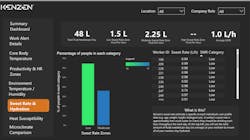Heat Protection PPE Becomes Even Smarter
A company that makes PPE with physiological monitoring platforms to keep workers from overheating on the job has made its system even smarter, adding the ability to track the heat susceptibility and sweat rate of individuals, key indicators in the detection and prevention of heat-related problems.
Classifying heat susceptibility
The Kenzen system calculates heat susceptibility of a worker and then classifies them into low, moderate, or high heat-risk categories. A proprietary algorithm determines the person’s heat risk category by evaluating their medical or physical conditions, physical fitness, heat-acclimatization status, history of heat injury and illness, medications, chronic illnesses, and age.
The classification does not reveal personal information or reasons why someone is in a particular heat risk category; it is only used, the company says, to help supervisors monitor and manage people according to their individual heat susceptibility.
“Managers have so much to worry about at their worksite, including if their workers are physically able to work safely to get the job done well and on time,” said Nicole Moyen, VP of research and development at Kenzen. “This new feature tells managers which workers to monitor closely on hot days, and when and how to alter an individual’s schedule or workload.”
Monitoring hydration
Kenzen also has a new sweat rate monitoring feature that uses a worker’s information and physiological data to calculate and predict their sweat rate, in liters per hour. A manager can view an individual’s sweat rate on an analytics dashboard, which also indicates how much water that person needs to drink each hour to stay hydrated.
The data eliminates the guesswork in how to keep workers safely hydrated. Now managers can provide enough water to the worksite to hydrate their teams sufficiently based on each individual’s sweat rate and the predicted environmental conditions that day. The proprietary sweat rate feature gives a hydration plan that is accurate within one quarter of a liter (1 cup of water), so that every worker will know the specific amount of water they need to drink that day to stay safe.
“There is no ‘one size fits all’ when it comes to hydration, which is why it’s important to use each person’s sweat rate for an individualized hydration plan,” said Moyen. “Dehydration is a major problem on worksites and increases the chances of someone getting a heat injury or illness, having an accident at the worksite, or suffering from cognitive impairment. Staying hydrated is a simple fix to avoid most of these problems.”
How heat monitoring PPE works
Kenzen devices worn by workers contain sensors that monitor, in real-time, an individual’s physiological responses. The worker is warned when their core temperature is too high and they are in danger of a heat-related injury or illness via a smart phone app and a device vibration. Managers have a corresponding app that alerts them when a worker needs an intervention to stop work, rest, and hydrate, and a second alert for when it’s safe to return to work. EHS leaders use the analytics dashboard to make individual, team or enterprise-wide decisions to minimize heat-related injury and illnesses across their worksite by looking at aggregated data across weeks to months.
The solution integrates the company’s commitment to data privacy; only workers can view the details of their personal health information, while safety managers and other EHS leaders only see what’s necessary to keep the workers safe.
Source: Kenzen
